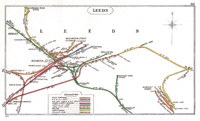Mystery Photos
I'll be running the occasional photo here which has stumped me, with information that I have established, updated with any fresh info that viewers can suggest. If anybody can help with identification, please get in touch!
Mystery colliery on the NE

While researching the coal traffic around Leeds, I bought this undated picture on eBay described as "Micklefield, Peckfield Colliery". That location is on the Garforth Field midway between Leeds and Selby. Alas, this is not it and I cannot place the actual location. A useful clue is what looks like an ex-NER J21 in the yard so we're probably talking about an ex-NER location somewhere else. The OS 25" map for Peckfield is shown below and compared with the photograph:
Click on the image for an enlargement
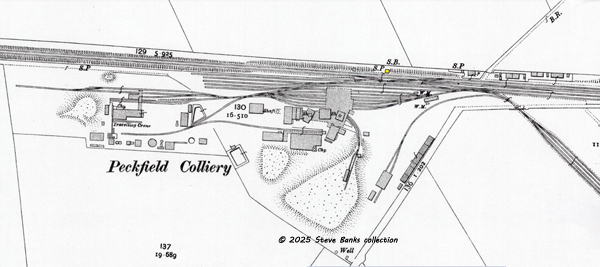
The OS 25" map for 1905-8 shows no double track junction, the colliery parallel to the running lines, and a signal box (shaded yellow) to the north.
The photograph shows none of that, a particular feature being the screens & loading building with 8-9 roads (compared with Peckfield's 7).
I have checked other collieries in this district so am stumped. It would be nice to know the actual location and if anyone can help, please get in touch via the Contact link!
Click on the image for an enlargement
Well, shiver me timbers, if Frank Routledge hasn't already come up with a solution (thank you Frank) that it's a colliery on the LNER line at Altofts Junction, less than a mile north of Normanton. It's actually one of two collieries next to each other, here is part of the 25" OS map:

This extract from 1932-33 shows the area in the photograph and a precise match with it. It looks like the photographer had climbed up a signal pretty well in front of a signal box so this was no casual snap, possibly to record repairs to the track. The curving LNER line leads to all points north - Leeds, York and Selby. The other line is the ex-MR route to Leeds. Both companies can be seen with connections to these collieries with as mentioned above, what looks like an ex-NER J21 on the NER/LNER side, possibly from Neville Hill.
Click on the image for an enlargement
K1 No 62066
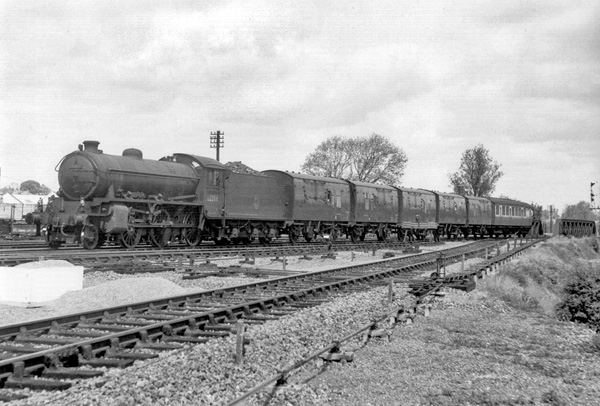
K1 No 62066 passes with a horse train made up with the BR Mk.1 style horse box. Can anybody identify the location? With a March loco, and fairly flat terrain, possibly not too far from Newmarket?
John Chalcraft (yes, he of Rail Photoprints) reckons that, having been to this location himself, the picture shows the train entering Ely from the north. Thanks, John, one of the longest standing puzzles solved at last! (11 April 2014).
C7 No 2208

Unresolved: Ex-NER C7 No 2208 approaches the camera at an unknown date and location. Express lights are being carried, which might suggest a portion, of Gresley 61'6" carriages, plus a horse box (ex-GER?) behind the tender. The loco lasted until Nov 1948 so the date could be late '30s or '40s.
BTK 3rd brake
CK 1st/3rd
BTK 3rd brake
On the high ground in the background is a staggered row of terraced houses.
Resolved below
King's Cross-Newmarket ticket

The return half of a complimentary King's Cross-Newmarket ticket for the Racecourse Betting Control Board. Does anybody know what this might be?
26th March 2014: I have struggled to makes sense of conflicting information on this one, with thanks to David Wilkins. One school of thought has it that the RBCB was set up to monitor attendances at race meetings, and was then tasked by the Government in 1928 to set up reliable, govt supervised betting, nicknamed "the tote" (after Totalisator). Another source states that the RBCB did not exist until the gov't created it as part of setting up the tote. Yet another source declares that the tote did not exist until 1961! I have yet to establish exactly where the truth lies.
One thing I can add with some confidence is that complimentary tickets for RBCB officials used to be issued by the railway. Racing reporters were granted the same privilege. This is the return half of a ticket from London.
Newcastle-Bournemouth on the GWR

Heading south, this cross-country train was brought by an LNER loco, an ex-GCR Atlantic or, later, a Footballer B17, into Banbury General (GWR) station where a GWR loco took over. It has recently come to light that "during the 1920s and '30s a large GWR Prairie tank was used as far as Oxford". This picture was taken by Maurice Earley and it's one of his earliest (it says No.10 on the back). My estimate for the date is 1926-27, but the location has defeated me: any suggestions?
- Bob Humphris has suggested c1923 but a better location has come from Martin Crane, who says that it's Tilehurst, where Maurice Earley took several pictures . A former signalman, Martin adds that key indicators are the Stop signal with a lower Distant, and a Shunt arm lower down the post. The train is on the Up main line with the relief lines further away, and the River Thames in the background.
Tilehurst is the last wayside station between Didcot and Reading and shows that the "Prairie" tank worked all the way from Banbury to Reading. At the time, the off-peak Newcastle-Bournemouth was a medium-sized train and the gradients were modest and many, falling. Whether or not a similar loco worked the Down train I cannot say, but 4-6-0s from Reading were certainly in charge later. I can't help musing that according to one expert on the GWR, the company treated the cross-country expresses as "secondary", and having looked at them in some detail, I consider that to be quite charitable!
The service itself got heavier from 1927 when, for five years, extra coaches were added to the train, from Leeds, and then Bradford as well. I would suggest that use of a "Prairie" tank ended that year. These coaches from the West Riding formed part of a Leeds-Bournemouth express and a write-up is in hand.
2510 Quicksilver with the Silver Jubilee

A4 No 2510 Quicksilver has the train, but what is the location?
- Steve Gwinnett (many thanks!) proposes: "leaving Hadley Wood North Tunnel which would, if correct, mean that Ganwick signal box (or site of) was about 100 yards behind the photographer's left shoulder. Can't be sure, though, despite growing up half a mile from there", (several other viewers have confirmed this).
- David Lester has just pointed put that 2510 was not actually "Silver Link" as per my original caption. I'm wondering how many of us have been in a dream-like state around these A4s and never noticed? Thank you David for the reality check. :)
C7 2202 and TPO

C7 No 2202 is heading south with a secondary express and a TPO behind the tender. My guess is that it's heading for Newcastle (or York?) and the wayside station would be on the ECML between Edinburgh and Newcastle (or York?). Can anybody identify the station, please? Click on the image for a larger, higher-res version. Photo copyright, Steve Banks collection.
Thanks to John Smart, the station has been identified as Longniddry, on the outskirts of Edinburgh. Other details about the working have also been resolved, helping make sure this picture will shine in "LNER trains etc." Vol.2 about the Secondary Services (now renamed by Ian Allan as: "Secondary, Branch Line and Non-Passenger Services").
Confirmation comes from Paul Tetlaw who has just travelled along the ECML, the curve and houses all fitting in, some three-quarters of a century later! (2-5-15)
SR 742 and express at Oxford station

This view comes from a CCQ slide whose uneven tones and debris I have cleaned up and balanced. Taken sometime in the 1930s it shows Southern Railway "King Arthur" No 742 Camelot at the head of a southbound express with 10-11 carriages behind the tender. Note the long distance coaches with destination boards, and among them what appear to be strengtheners, some of which may have been added at Oxford. The staff on the ground by the train would have been involved in remarshalling the train. They seem to be waiting for the off so they can climb back on the platform. At the head, it looks like a fresh loco with safety valves blowing off has taken over the train for its next leg to the south.
The question is, what was the express?
There are two cross-country candidates for which I quote from the LNER 1939 (summer) Working Timetable:
10.10am Newcastle-Bournemouth - arr Oxford 2.53pm : alternating LNER and SR stock.
2.55pm Newcastle-Southampton - arr. Oxford 7.56pm : alternating LNER and GWR stock (actually the Glasgow-Southampton, remarshalled at Newcastle)
Based on the angle of the shadows in the picture and keying 2.53pm into a solar calculator gives a good match, for 2.53pm, not for BST but the "winter" period between the end of October and end of March. This would of course be in the railways' winter timetable and on a fine day give a photographer plenty of low-slanting sunlight.
The puzzle is that a mixture of GWR and SR stock would suit neither train. It's almost as if the two cross-country trains were in some way combined. And I have no knowledge of such a practice, even though all my Carriage Working Books are for summer period. Any ideas, anybody? Or was this a different train altogether that arrived at a similar time?
John Smart has come up with an explanation, referencing the May 1934 Bradshaw, with two possibilities where GWR and SR stock was carried on alternate days. The first was a service between Birkenshead-Brighton and the SE coast ports, leaving Oxford at 12.12pm.
More likely, however, and tallying with the sun angle, was the Birkenhead/Manchester to Southampton and Bournemouth, with through coach Manchester-Portsmouth, which departed Oxford at 2.25pm. Well done, John! :)
More recently, the slide has been dated as April 1939.
Click on the picture for an enlargement.
2851 and Banbury Shed Master

Ex-works ex-GWR 2-8-0 No 2851 stands in the shed yard on 21st April 1959 with what appears to be an 84C shedplate. The caption on the back states "and shed foreman". Photo: SV Blencowe Collection

Can anybody identify this man, and was his title really "Shed Foreman"? Looks more like the Shed Master to me!
News has come through from John Batts, that this was Shed Master George Holland. :)
Banbury and Collett 3216

Here is an undated picture of Collett 2251 Class, No 3216 and the location is unmistakably Banbury. The real puzzle is when? Below is an enlargement of the smokebox door showing the 84C shedcode. According to my half dozen ABC shed books, I cannot trace the loco as having been at Banbury and the website BRDatabase quotes:
pre-1953 - not stated 16.5.53 to 84F Stourbridge Jc 30.1.54 to 87G Camarthen 18.6.55 to 85A Worcester 8.10.60 to 92G Templecombe 12.63 withdrawn
Does this lead us to conclude, bearing in mind that BR style front number plates weren't seen here until around 1950 and this looks like a high summer's day, that the picture was taken sometime between 1950-52?
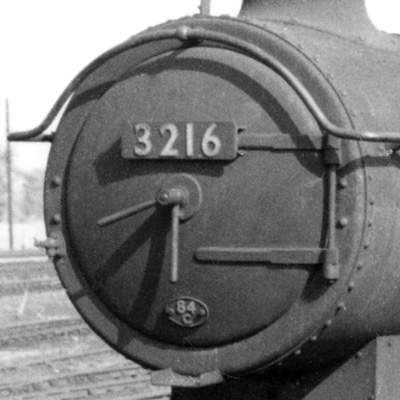
John Smart has been in touch to say that several records (that I could not find; John's good at this!) show that 3216 was at Banbury from Nationalisation in 1948, departing to Stourbridge as shown above. I'm embarrassed to say that this is one of the quickest resolutions to date!
N2 2587 pick-up goods
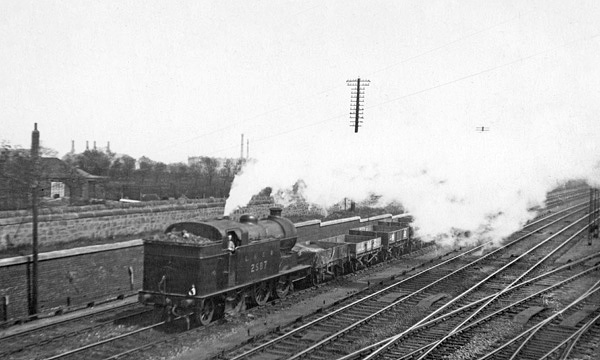
Another mystery picture with an Ivatt 0-6-2T, this time an N2. The photographer is unknown and the quality is a bit iffy: again, I have done my best to fix it with Photoshop CS.
- - - - - -
Not the West Riding after all, thanks go to Rob Stout, member of the North British Study Group (see Useful Links), who has recognised the location as near Craigentinny Signal Box, Portobello, on the east side of Edinburgh, a few miles out from Edinburgh Waverley.
If my map reading is up to scratch the pair of lines in the middle are the ECML towards Newcastle and King's Cross and the junction to the right leads into Craigentinny depot and carriage sidings. The pair of tracks to the left are the goods lines with a junction further north that parted off towards Granton Harbour, and that's the direction the Class D "pick-up goods" may have been heading.
The loco was one of a batch 2583-94 that was sent new to Scotland in the spring of 1925 and allocated initially to Dundee, St.Margaret's and Eastfield, on passenger duties except for the St.Margaret's ones which were initially put on the goods transfer trips around Edinburgh. See RCTS 9A for more details about subsequent developments.Reading between the lines, I get the feeling that Doncaster may not have been best pleased about brand new passenger tanks being relegated to duties as humble as this. The train is quite short and not unusual for the 1920s when relatively low-sided wagons were numerous. The leading three visible here, and a telling point is continued carriage of pre-Grouping liveries, are:
- 3-plank dropside with a loose tarpaulin sheet, still in GCR livery with grease boxes and handbrake lever to the left. - 2-plank LMS (possibly ex-MR)? - 4-plank ex-HR, with a primitive brake lever arrangement. Confirmed by John Smart, who prompted me to make a hi-res scan of the wagons, in which the lettering is clear to see.

Click on the image for an enlargement
Dare I conclude by saying that this reminds me of my first ever train set, boosted by second-hand wagons from the model shop in Leeds, and when I eventually started building wagons from scratch in the days before kits were available (the magazines used to be full of helpful articles by the LNER Study Group and the LMS Society), wagons like this were easy to knock off. Oh, happy days!
Map
For those wishing to delve deeper into the scene, Rob Stout has flagged up the OS map of 1934 courtesy of the National Library of Scotland whose stunning presentation shows Edinburgh around Portobello. The link below takes you straight there - return by using the browser "back" button.
Rob adds that the walled footpath to the left was called the Fishwives' Causeway.
Click on the image for an enlargement
Mystery horse box in two trains
Two sets of pictures with horse boxes, since updated and moved into the topic "Horse and Race Traffic" with a sub-section focusing on LMS horse boxes.

This is LGRP 21135 and shows a NBR-built Wheatley 0-6-0 approaching Carlisle with a train of 6-wheel and bogie passenger carriages; a 4-wheel passenger brake van; and a horse box. The headlamps are not RCH-related but a local one so I cannot tell if this was an express or ordinary passenger train. I suspect that the code probably indicated the route being served, a practice which lasted beyond the Grouping in several parts of the UK.

An enlargement of the two non-passenger vehicles shows more of the horse box. Oil axleboxes are evident, a fixture that was becoming normal on coaching stock built after around 1900.

The second view shows an LMS train in 1925 at Blackwell being banked up the Lickey Incline. 2P 4-4-0 No 521 has an Ordinary Passenger train comprising four bogie carriages, mostly clerestory, flanked by vans: ex-Midland Railway 6w at the front and on the rear, ex-LNWR, still in LNWR livery, a common sight during the 1920s. Behind the loco, however, are five horse boxes.
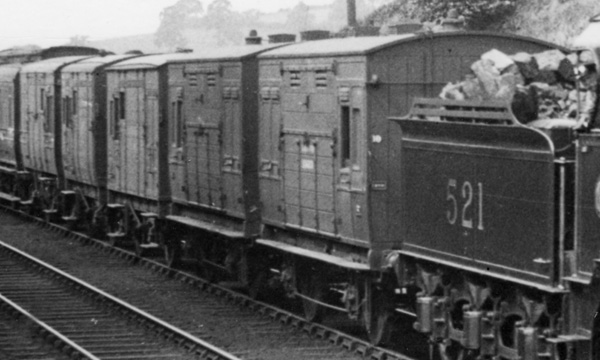
The trailing three are indistinct but look like Midland Railway designs, of which there were several different types, both flat-sided and with tumblehome, arc roof and elliptical. At the head there are two more examples of the mystery design.
In Peter Tatlow's "Historic Carriage Drawings, Volume Three, Non-passenger Coaching Stock" (Pendragon, 2000), page 75 shows a Maryport and Carlisle horse box, No 4, which Peter concluded was the sole survivor listed in the LMS renumbering in 1932. The body profiles are similar and there are several similarities in detail.
Philip Millard, well known for his LNWR researches, has come forward to identify the mystery design in both pictures so I have trimmed my thoughts and quote Philip thus:
"A considerable number of these 21ft boxes was built by the LNWR to Diagram 436. In all, 692 were produced between 1890-1923 and the ones at Blackwell are earlier examples built on steel channel frames with rounded ends to the headstocks. They have the 1901 pattern of oil boxes. The first one is a pre-1896 example with horns outside the solebars. The second appears to be post-1896 with horns inside the solebars.
The one at Carlisle is a later, post-1899 build on bulb-iron frames with square-end headstocks, and it too has oil boxes, of the 1916 type.
There were still about 699 of these horseboxes in capital stock at the Grouping, and 247 in 1933. The type did not become extinct until 1954".

At this point it's fair to show the preceding LNWR Diagram 438 to 19'6" because it is covered by London Road Models, whose illustration is shown above. The website states that this Diagram had been built between 1883-1889. 150 were constructed, 88 of which were still running in 1915. By 1920 they had all been replaced by the newer design. London Road Models can be found via the Useful Links section in the main menu.
As regards M&CR horsebox No 4 which was built in 1904 and shown in Peter Tatlow's book, although built by R.Y. Pickering of Wishaw near Motherwell in Scotland, it appears to have been based on contemporary LNWR designs with a few simplifications, such as one less door to the fodder compartment.
Click on the image for an enlargement
Workings - All of which brings us back to the train pictures and possible workings. Philip Millard tells me that there used to be a weekly sale of horses at Crewe, to and from which horses would be sent by rail. The LNWR would have despatched using its own boxes, and after the Grouping, ex-MR ones too. There were other sales, of course, around the country in the same way that second-hand cars are traded these days and I'm wondering if the ex-MR and ex-LNWR horse boxes at Blackwell were part of a sale, at Gloucester, for example, or possibly empty boxes being returned? I think that race traffic can be ruled out.
2P 40659 at Crewe

I got this picture for the view of the train being loaded, hauled ex-LMS 2P 4-4-0 No 40569, which is carrying a 5A Crewe North shed plate. The date appears to be sometime in the 1950s, the loco moving to Watford in 11/59. Withdrawal came a few years later in 6/61. A single lamp is being carried over the LH buffer, which would indicate a pick-up goods, but it may be a "light engine" light that hasn't been changed yet. My guess is that it's a parcels working. The location, however, has defeated me - can anybody recognise it?
Gordon Luck has come to the rescue - it's an Up train at Crewe station, platform 6. Armed with that info the presence of ex-GWR vans, a pair of Siphon Gs (early and late versions), behind the loco suggests a Parcels working to Shrewsbury. There used to be a working from Crewe to Bristol although the only source I have is for 1935-36 when it ran overnight and comprised almost entirely GWR vehicles: passenger brake vans and Siphons. Rostered for up to eight vehicles, if this was a comparable service in early BR days it would have been no problem for a lightweight ex-LMS 2P. Presumably, Shrewsbury took over with a GWR loco.
Click on the image for an enlargement
A3 2747 Coronach at Waverley

This is based on Colour-Rail NE106 with my apologies for the mediocre colours; the original, a Dufaycolor slide, was exposed on a dull day and the duplicate from C-R quite strongly vignetted and blue; I have done my best to restore it.
The scene is Edinburgh Waverley in August 1939 and A3 No 2747 Coronach is about to depart with the LMS formation of the Up "Thames-Forth" * express. In the background stands a K3 and a Gresley 61'6" 3rd (TK)
All good stuff, but I got the picture because of the 6w van behind the tender - it's one of the rarely photographed ex-NBR Fruit and Yeast Vans (LNER Wagons-3, p.59, Peter Tatlow).
The livery is intriguing, too, for this was classed as a goods van, even though fitted with AVB and through steam heat pipe. The body colour can be loosely described as brown and I think I can see the large white letters "NE" placed fairly centrally, between the doors. Further text would have been placed below them, and the slide seems to show what may be two words, in yellow??
Click on the image for an enlargement
*Route of the Thames-Forth express - Heading south was: Edinburgh-Carlisle via the Waverley Route Carlisle-Leeds via the Settle & Carlisle Leeds-St.Pancras via the Midland main line through Derby.
After the hiatus caused by WWII, the service was not actually restored until 1956, when BR renamed it "The Waverley". But it was not to last and after an initial reduction to summer-only, it was withdrawn in 1968.
Iain Chalmers, member of the NBR Study Group, has come forward to say there could be two of these yeast vans behind the tender. He believes that much of the yeast was a by-product from the beer industries around Alloa and that these despatches could reach Burton-on-Trent in the Midlands. It's interesting that the NBR gave these vans a passenger livery (ie. NPCS) while the LNER regarded them as goods vehicles - a bit strange for a 6w vehicle fully up to NPCS specifications and running with expresses, but you have to get used to inconsistencies in railway practice.
There's more work to be done here but already there is the tantalising prospect for LNER and LMS modellers to run these vans.
How the yeast vans were taken on to Burton-on-Trent is not yet known. It's possible that they may have been attached to other passenger services, from Derby for example, by which time thanks to the change of direction at Leeds City, the Yeast Van would have been on the rear. And possibly returned via goods trains?
Any further ideas/corrections would be welcome (via the Contact/feedback link, please)!
Banbury - directional signal
There was what might be called a directional or route-indicating signal at Banbury South, where the Down Loops terminated and Banbury Loco came in. Here are some pictures from the files:

Heading south past the gasworks on Friday, 27th June 1958, is Banbury's Churchward 2-6-0 No 5306 with a train from the ER. (see Banbury Expresses for details).

"King" no 6014 King Henry VII comes out of the mist at Banbury South with a Down express on 29th April 1960 (see Banbury Expresses for details). 3845 is waiting to come off shed.

Two closer views of the signal with the levers for several indicators. Photos author's collection.
If anybody can offer more detail, please get in touch via Contact/feedback.
Click on the image for an enlargement
GCR 8B at unknown location

GCR 8B No 358 with a heavy train of 11 assorted carriages. The writing on the back states:
"Manchester-London express passing Godley".Photo: Author's collection Click on the image for an enlargement
This picture caused much controversy. The stated location is on adjacent sheets of the 25" OS map so I've combined the 1907-19 ones including part of the scale:

Click on the image for an enlargement
As can be seen Godley Junction is to the NW and the approach to Hattersley Tunnel to the SE. The junction station had two platforms on the west (CLC) and two on the east (GCR) from Manchester. There are many sidings around the station and 2-track running lines don't come clear until some distance south of the platforms. There's a signal box at this point. A little after that a shallow cutting begins, which rises higher towards the tunnel mouth.
By way of comparison, there's an earlier picture on p.10 of "GC Album", George Dow, which shows the station close to the end of the platforms.
Now, a confession for a daft mistake on my part: the scale on the map is not in yards but feet so my previous estimate of the distance between the station platforms and where the double track emerged was wrong (actually 1300 feet or 430 yards, a quarter of a mile).
Secondly, a short distance south of the signal box the map shows "S.Ps" for signals and the photograph appears to show stays and their shadows. This could be the photographer's location:

In this enlargement of the area around the south signal box I have placed a blue cross where the photographer appears to have been standing. It also shows that the signal box would have blocked sight of the sidings. A closer look at the extreme left of the photograph shows a vague structure: could this be a tall wooden signal box? With perhaps a fogman's hut nearby? The black marks in the foreground are pulley-wheel posts for signal wires. Map source: 25" OS, National Library of Scotland.
So, the location is near Godley Jc after all.
The train

An enlargement from the original scan with minimal repair to avoid damaging the pixels. Click on the image for an enlargement
As far as I can tell the carriages are:
GNR 6w |
C |
|
GNR 6w |
T |
|
GNR 6w |
T |
|
--------------------------------- |
------ |
|
GNR 12w double-ended* |
BCK |
with reversed destination boards? |
GNR semi-open |
TK |
with reversed destination boards? |
GNR |
BCK |
with reversed destination boards? |
--------------------------------- |
------ |
|
GCR Parker-style** |
TK |
|
GCR Parker |
BTK |
|
GCR clere |
T |
|
GCR ex-MSJ&A |
T? |
|
GCR ex-MSJ&A |
? |
|
* These were rebuilt later. ** Built by Robinson to the GCR house style.
The writing on the back "Manchester-London express" is implausible because of the mixture of stock:
- It could be a heavy excursion made up with a borrowed GNR portion and low-grade carriages on either side, but such a mixture of two company's carriages is implausible.
- The loco had been put into traffic in May 1906 and the surrounding foliage looks like the same time of the year. The loco is very clean and possibly newly-built. I wonder if if this could have been a test train comprising idle stock from the carriage sidings?
.J68 at Neasden

When I came across the negative of this picture, taken on 19th September 1958, I was puzzled by the locos, well, one of them. There's an ex-GCR N5, which Neasden used as pilots, and a Thompson B1, several of which were allocated in the 1950s. But centre stage is an ex-GER J68 with a 30A Stratford shed plate.
Over the years Neasden had temporary allocations of several lesser classes, including ex-GER N7 0-6-2Ts to help serve exhibitions at Wembley but I can't imagine an 0-6-0 J68 or J69 being used for that. When locos were transferred they didn't immediately gain a new shed plate so presence of Stratford's is not really significant. The records don't show an official transfer anyway. I'm wondering if it was tried on pilot duties, and then sent back? The answer may be in back issues of railway magazines for 1958, or maybe somebody's memory? It would be nice to know; if anyone can help, please, get in touch via the Contact link!
Robert Ward has come forward to say that he visited NEA that month and didn't see this loco so we still don't know what it might have been doing there - and that it was a J68. Caption corrected, thank you.
Click on the image for an enlargement
Related locations on the GCLE:

